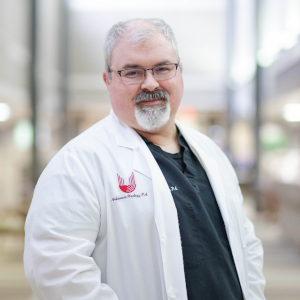Prostate Cancer Care at Arkansas Urology

Prostate Cancer
Prostate cancer is the second-leading cause of cancer deaths among men in the United States. It is the most common cancer among men after skin cancer. However, when detected in its early stages, prostate cancer can be effectively treated and cured. Factors such as age, family history and a diet high in fat may increase the risk for developing prostate cancer. It is more common in men over age 50 and African-American men. There are usually no symptoms of prostate cancer in the early stages. When symptoms do appear, they may include:
- Difficulty or inability to urinate
- Decreased strength of urine stream
- Waking at night to urinate
- Frequent urination
- Painful urination
- Painful ejaculation
- Blood in the urine or semen
- Deep pain in the lower back, abdomen, hips or pelvis
- Loss of appetite and/or weight
- Persistent bone pain
Screening and Diagnosis
Importance of Early Detection
Early detection through prostate cancer screening greatly improves survival rates. Prostate cancer screening should be performed under the principles of shared decision making and should begin at 45 in average risk men and 40 in high risk men. Early-stage prostate cancer often has no symptoms, making routine screening critical. A timely prostate cancer diagnosis can significantly improve outcomes.
Screening Tests
Three tests are commonly used to help detect prostate cancer:
- Digital Rectal Exam (DRE): A doctor examines the prostate through the rectum to find hard or lumpy areas.
- PSA Test: A blood test used to detect a substance made by the prostate called prostate-specific antigen (PSA). Elevated PSA readings can be a sign of prostate cancer.
- Prostate MRI (pMRI): A non-invasive imaging test that provides detailed pictures of the prostate. pMRI is very commonly used before a biopsy to help determine if suspicious areas are present and guide targeted sampling.
Neither of these initial tests for prostate cancer is perfect. Many men with a mildly elevated PSA do not have prostate cancer, and 15% of men with prostate cancer may have normal PSA levels (<4.0ng/dl). The most comprehensive way to detect prostate cancer is to use both the PSA test and DRE.
Your care team at Arkansas Urology will guide you through additional diagnostic steps as needed.
Prostate Biopsy
If your doctor is concerned about the results of your PSA test or DRE, additional tests may be recommended. Prostate cancer can only be definitively diagnosed by performing a prostate biopsy, where a small sample of prostate tissue is removed and examined under a microscope. Arkansas Urology performs these biopsies at ourCenterview Surgery Center procedure area with the assistance of anesthesia sedation.
The two most common types of biopsies are transperineal and transrectal.
Advanced imaging tests, such as MRI scans and CT scans, may also be recommended to assess if cancer has spread beyond the prostate gland to nearby areas.
Possible short paragraph about Gleason score and risk stratification, like we did for bladder cancer.
Treatment
Prostate cancer treatment depends on several factors, including:
- How advanced the cancer is
- Your health and other medical conditions
- Your age and life expectancy
- The potential side effects of treatment
Initially, prostate cancer can be treated with active surveillance, hormone therapy, radiation therapy, chemotherapy or surgery:
Active Surveillance
Active surveillance is often the preferred treatment for men who have slow-growing cancers or limited life expectancy due to age or medical conditions. This involves regular checkups and monitoring of cancer growth. Active treatment may be recommended if symptoms worsen.
Hormone Therapy
Hormone therapy aims to control prostate cancer by limiting the supply of hormones that cancer cells need to grow, particularly testosterone. It is typically used in more advanced prostate cancer cases.
Radiation Therapy
Radiation therapy is usually used for patients whose cancer is confined to the immediate prostate area, but it can also be used in advanced cases to control pain. It can be delivered from outside the body or by implanting radioactive beads or other material inside the prostate. Radiation works by damaging tumor cells that divide quickly.
Brachytherapy
Brachytherapy is a type of internal radiation in which radioactive material in the form of “seeds” is placed into or near a tumor in the prostate gland. With this procedure, high doses of radiation can be delivered to the immediate area of the tumor, minimizing damage to nearby tissues. The procedure takes less than an hour and generally does not require an overnight hospital stay. The seeds are placed using thin needles inserted through the perineum, guided by ultrasound. They emit radiation for several weeks and continue to stay in place, causing no harm to surrounding tissues. Brachytherapy is not recommended for large or advanced tumors but is extremely advantageous for men with smaller tumors. The procedure is less invasive, takes less time, is less costly and has fewer side effects than external radiation or surgery. More than 90 percent of patients continue to be disease-free five years after the procedure.
Chemotherapy
Chemotherapy uses drugs to slow or reverse the spread of prostate cancer in advanced cases. The drugs are injected into the bloodstream and poison the rapidly dividing cancer cells. However, the drugs also affect healthy, dividing cells in the blood, intestine and hair. Common side effects include nausea, hair loss and anemia, which may be helped with other medications.
Intensity-Modulated Radiation Therapy (IMRT)
IMRT is an advanced method of high-precision radiotherapy that uses computer-controlled X-ray accelerators to deliver precise radiation doses to a malignant tumor or specific areas within the tumor. IMRT is more precise and controlled than other forms of radiation. IMRT also allows higher radiation doses to be focused on specific regions within the tumor while minimizing the dose to surrounding healthy tissue.
Surgery
Surgery is typically performed when tumors are still confined inside the prostate during early stages of prostate cancer. Surgery is intended to remove all cancerous tissue and cure the cancer. Surgical options include the following:
- Open Radical Prostatectomy: A major surgical procedure to remove the entire prostate, along with both seminal vesicles and other surrounding tissues, including a section of the urethra and part of the sphincter muscle. Radical prostatectomy is a recommended treatment option for patients whose cancer is localized, or confined to the prostate, and for younger patients who have a high-grade tumor. Radical prostatectomy is a procedure that takes two to four hours to perform and requires at least a three-day hospital stay. Patients must wear a catheter for 10-21 days following surgery. Certain risks and complications are involved with prostatectomy, including bleeding, infection or cardiopulmonary problems. More serious problems can include urinary incontinence, stool incontinence and impotence. Most patients experience some level of incontinence following the procedure that improves over time. Impotence was once inevitable following prostatectomy, but today that risk may be reduced with nerve-sparing surgical techniques. The Gleason score is often used to determine if surgery is appropriate.
- Da Vinci Robotic Surgery: Uses small laparoscopic instruments that are inserted through small incisions in the abdomen to dissect and remove the cancerous prostate gland. This procedure is less painful and requires a shorter period of recovery than radical prostatectomy but achieves the same level of cancer control. The typical hospital stay is 36 hours with a recovery period of two to three weeks, compared with a 72-hour hospital stay and six- to eight-week recovery period with radical prostatectomy. Da Vinci Robotic Surgery is a minimally invasive procedure that requires four or five small incisions at or below the navel. The da Vinci system provides clarity to help the surgeon identify muscles that control continence and nerves involved with sexual function, reducing side effects such as urinary incontinence and sexual dysfunction.
Cryosurgery
Cryosurgery is less invasive than traditional surgery, involving only a small incision or insertion through the skin, and uses liquid argon gas to destroy cancerous tissue. For years, cryosurgery has been used to treat skin cancers. Now, physicians are using the procedure in cancer treatment of the liver, prostate, pancreas and kidney. Researchers have determined that cryosurgery is a good alternative to surgery or radiation therapy, both of which often have severe side effects. Because physicians can focus on a limited treatment area, destruction of nearby tissue is reduced. This minimizes pain, bleeding and other complications of surgery. Cryosurgery also requires shorter recovery time and is typically an outpatient procedure. Cryosurgery is especially good for men who cannot have traditional surgery due to their age or other medical problems. The procedure is also a good alternative for those patients who have had unsuccessful radiation therapy. The cryosurgery process works by using argon gas to freeze and destroy cancerous cells. Argon gas is circulated through a hollow instrument called a cryoprobe, which is placed inside the tumor. A ball of ice crystals forms around the probe, freezing nearby cells. Ultrasound is used to guide the cryoprobe and monitor the freezing of the cells, thus limiting damage to nearby healthy tissue. After cryosurgery, the frozen tissue thaws and is naturally absorbed by the body.
Advanced Treatments
If prostate cancer progresses, there are more aggressive treatments that can be offered. These include immunotherapy with Provenge, oral medications, SpaceOAR Hydrogel, and advanced radiation treatment with Xofigo. Patients with high-risk or advanced prostate cancer may also consider enrolling in clinical trials that offer access to the latest therapies.
After Treatment: Living with Prostate Cancer
Patients who undergo prostate cancer treatment may face challenges such as urinary incontinence, erectile dysfunction, or fatigue. Arkansas Urology offers follow-up support and a personalized care plan to monitor for recurrence, track PSA levels, and improve overall health after treatment.
Joining a support group can help many prostate cancer patients adjust emotionally and physically after treatment.
Research and Prevention
Arkansas Urology stays connected with the latest prostate cancer research developments supported by organizations like the Prostate Cancer Foundation, the National Cancer Institute, and the American Cancer Society.
Maintaining a healthy lifestyle — including a diet rich in fruits, vegetables, and lower red meat intake — and staying active may reduce your risk for prostate cancer. Regular screening ensures early detection and better outcomes.
Men with a family history, African-American men, and individuals with genetic factors should be particularly aware of their higher risk and consult their care team about appropriate screening intervals.












